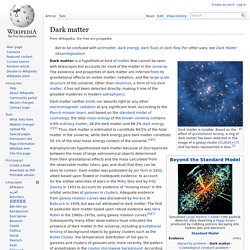

Dark Matter - Introduction. Martin White: Dark Matter. We believe that most of the matter in the universe is dark, i.e. cannot be detected from the light which it emits (or fails to emit).

This is "stuff" which cannot be seen directly -- so what makes us think that it exists at all? Its presence is inferred indirectly from the motions of astronomical objects, specifically stellar, galactic, and galaxy cluster/supercluster observations. It is also required in order to enable gravity to amplify the small fluctuations in the Cosmic Microwave Background enough to form the large-scale structures that we see in the universe today. For each of the stellar, galactic, and galaxy cluster/supercluster observations the basic principle is that if we measure velocities in some region, then there has to be enough mass there for gravity to stop all the objects flying apart. When such velocity measurements are done on large scales, it turns out that the amount of inferred mass is much more than can be explained by the luminous stuff.
For more information. Dark Matter 2. Dark Universe / Transient Universe | Outer Solar System | Near Earth Objects | Milky Way | LSST Tour Dark Matter | Dark Energy | 3D mass Illustration of strong gravitaional lensing.

Click for full-size image. Strong gravitational lensing happens when there is so much mass contrast in the lens that the light rays from a distant source bend around both sides of the lens and cross near Earth. Then multiple images of the source may be seen. Clicking on each image below will bring up MPEG movies (800 kB) showing the evolution of the distortion as the clusters move against the background over half billion years. Two simulations of strong lensing by a massive cluster of galaxies. Dark Matter. Dark matter. Dark matter is invisible.

Based on the effect of gravitational lensing, a ring of dark matter has been detected in this image of a galaxy cluster (CL0024+17) and has been represented in blue.[1] Dark matter is a hypothetical kind of matter that cannot be seen with telescopes but accounts for most of the matter in the universe. The existence and properties of dark matter are inferred from its gravitational effects on visible matter, radiation, and the large-scale structure of the universe. Other than neutrinos, a form of hot dark matter, it has not been detected directly, making it one of the greatest mysteries in modern astrophysics. Astrophysicists hypothesized dark matter because of discrepancies between the mass of large astronomical objects determined from their gravitational effects and the mass calculated from the observable matter (stars, gas, and dust) that they can be seen to contain. Overview[edit] Baryonic and nonbaryonic dark matter[edit] Observational evidence[edit]
How Dark Matter Works" In the 1978 follow-up album to "Born to Run," Bruce Springsteen uses darkness on the edge of town as a metaphor for the desolate unknown we all face as we grow up and try to understand the world.

Cosmologists working to decipher the origin and fate of the universe must identify completely with The Boss' sense of tragic yearning. These stargazing scientists have been facing their own darkness on the edge of town (or on the edge of galaxies) for a long time as they try to explain one of astronomy's greatest mysteries. It's known as dark matter, which is itself a placeholder – like the x or y used in algebra class – for something unknown and heretofore unseen. One day, it will enjoy a new name, but today we're stuck with the temporary label and its connotations of shadowy uncertainty.
Just because scientists don't know what to call dark matter doesn't mean they don't know anything about it. So what is dark matter?